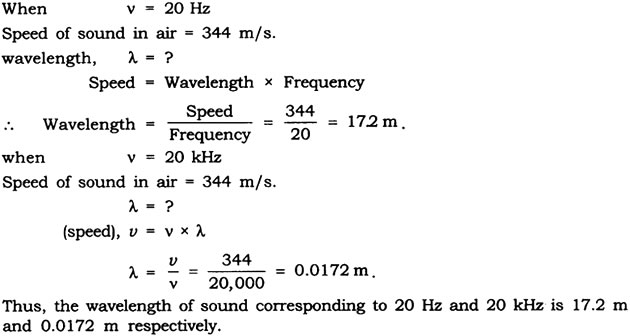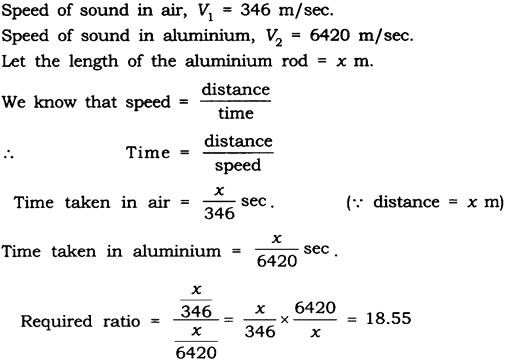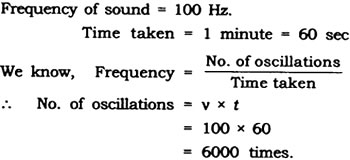Question: Define the ‘frequency’ and ‘time period’ of a wave. What is the relation b/w two.
Answer: The number of complete waves (or cycles) produced in one second is called frequency of the wave.
The time required to produced one complete wave (or cycles) is called time period of the wave.
Now,
In T seconds, no. of waves produced = 1
In 1 second, no. of waves produced = 1/T
But the number of waves produced in one second is frequency.
So,
Frequency = 1/Time period
∴ f = 1/T
Question: The frequency of the sound emitted by the loudspeaker is 1020 Hz. Calculate wave length is V = 340 m/s
Answer:
Frequency ( f ) = 1020 Hz
Velocity (V) = 340 m/s
Wavelength λ = ?
Now, V = f × λ
340 = 1020 × λ
340/1020 = λ
λ = 0.333 m = 33.3 cm.
Question: The speed of sound in water is 1500 m/s How far away from an under-sea rock should a deep sea diver be so that he can hear his own echo?
Answer: Speed = 1500 m/s
Time = 1/10 = 0.1 s
Distance = s × T
= 1500 × 1/10 = 150 m.
So, minimum distance = 150/2 = 75 m.
Question: The echo of a sound is heart after 5 seconds. If the speed of sound in air be 342 m/s, calculate the distance of the reflecting surface.
Answer:
Distance = s × T
= 345 × 5
= 1710 m.
Distance = 1710/2 = 855 m.
Question: (1). What is sound? What type of waves are sound waves in air.
(2). Describe an experiment to show that sound cannot pass through vacuum.
Answer: (1). The form of energy that makes is hear is called sound. Sound waves in air are longitudinal waves.
(2). Experiment:
- A ringing electrical bell is placed inside an air taught glass jar (bell jar) containing air we can hear the sound of bell easily.
- The bell jar is placed over the plate of vacuum pump. Air is gradually removed. As more & more air is removed, the sound becomes fainter and fainter.
- If air filled again, the sound can be heard again.
- This should that sound cant pass through vacuum.
Question: (1). An electric bell is suspended by this wires in a glass vessel and set ringing. Describe and explain what happens if air is gradually pumped out of the Glass vessel?
(2) Why cannot a sound be heard on the moon?
Answer:
- As our is pumped out of a glass vessel, vacuum s created in the vessel. Since sound cannot pass through vacuum, we are not able to hear the sound of electric bell anymore.
- There is vacuum in outer space & moon, So, we cannot hear sounds on the moon. Astronauts use radio waves to talk on moon.
Question: Define the terms ‘frequency’, ‘wavelength’ and ‘velocity’ of a sound wave. What is relation between them.
Answer: The number of complete waves produced in one second is called frequency of the wave.
The minimum distance in which a sound wave repeats is called its wave length.
The distance travelled by a wave in one second is called its velocity.
We know that, Velocity = Distance/Time
V= λ/T (wave length)
Question: A body vibrating with a time period of 1/256 s produces a sound wave which travels in air with a velocity of 350 m/s. Calculate λ .
Answer:
We know,
Time period = 1/256 s
also, f = 1/T
f = 1/1 × 256/1 = 256 Hz
Now, V = f × λ
350 = 256 × λ
350/256 = λ
λ = 1.36 m.
Question: Explain the terms ‘compression’ and ‘rare fractions’ of a wave. What type of waves consist of compression and and rare fractions?
Answer: A compression is that part of a longitudinal wave in which the particles of the medium are closer to one another that they normally are and there is a momentary reduction in volume of the medium.
A rarefaction is that part of a longitudinal wave in which the particles of the medium are father apart than normal and there is a moment increase in the volume of the medium.
Longitudinal waves consist of compression and Rare factions.
Question: A worker lives at a distance of 1.32 km from the factory. If the speed of sound in air be 330 m/s, how much time will the sound of factory siren take to reach the worker.
Answer:
(λ) 1.32 km = 1320 m
(V) velocity = 330 m/s
f = ?
V = f × λ
f = V/λ
= 33o/1320 Hz
Also, T = 1/f
= 1/1 × 132/33 s
= 4 seconds.
Question: Explain the terms ‘crest’ and ‘troughs’ of a wear? What type of waves consist of crests and troughs?
Answer: The elevation or hump in a transverse wave is called crest. The depression or hollow in a transverse waves consort of crests & troughs.
Question: The flash of gun is seen by a man 3 seconds before the sound is heard. Calculate the distance of the gun from the man (speed of sound in air is 332 m/s).
Answer:
Now, speed of sound = 332 m/s
Time = 3 sec
Distance = speed × Time
= 332 × 3
= 996 m.
Question: Flash and thunder are produced simultaneously. But thunder is heard a few seconds after the flash is seen, why?
Answer: Speed of sound is 330 m/sec in air medium at 0°C. Whereas speed of light is 3 x 108m/sec. When we compare the speed of light with that of speed of sound, speed of light is greater than that of speed of sound. Therefore thunder is heard a few seconds after the flash is seen.
Question: A person has a hearing range from 20 Hz to 20 kHz. What are the typical wavelengths of sound waves in air corresponding to these two frequencies? Take the speed of sound in air as 344 ms-1.
Answer:
Question: Two children are a± opposite ends of an aluminium rod. One strikes the end of the rod with a stone. Find the ratio of times taken by the sound wave in air and in aluminium to reach the second child.
Answer:
Question: The frequency of a sources/ sound is 100 Hz. How many times does it vibrate in a minute?
Answer:
Question: Does sound follow the same laws of reflection as light does? Explain.
Answer: Yes. Sound follows the same laws of reflection as that of light because,
- Angle of incidence of sound is always equal to that of angle of reflection of sound waves.
- The direction in which sound is incident, the direction in which it is reflected and normal all lie in the same plane.
Question: When a sound is reflected from a distant object, an echo is produced. Let the distance between the reflecting surface and the source of sound production remains the same. Do you hear echo sound on a hotter day?
Answer: Time = Distance/Speed
Time is inversely proportional to the speed. As the temperature increases, the speed increases. Thus on a hot day due to high temperature the speed of sound increases. Hence the time will decrease and we can hear the echo sooner.
 Class Notes NCERT Solutions for CBSE Students
Class Notes NCERT Solutions for CBSE Students






